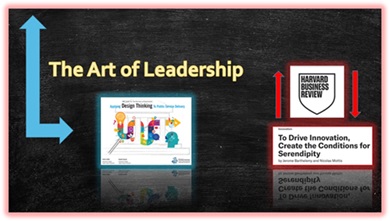
Fostering Innovation in Government: Leveraging Serendipity and Design Thinking

Innovation in government is often perceived as a daunting challenge, constrained by bureaucratic structures, risk-averse cultures, and siloed operations. Yet, the need for innovative solutions to complex public sector problems—ranging from healthcare delivery to transportation security—has never been more pressing. As I delved into a recent Harvard Business Review article, To Drive Innovation, Create the Conditions for Serendipity by Jerome Barthelemy and Nicolas Mottis, I found myself reflecting on the IBM Center report Applying Design Thinking to Public Service Delivery by Jeanne Liedtka and Randy Salzman, recognizing how their insights on fostering innovation complement each other and revealing how design thinking can amplify the serendipitous innovation they advocate.
This blog essay explores how government leaders can create conditions for serendipity, as outlined in the HBR article, and enhance these efforts through the principles of design thinking, as detailed in the IBM Center report .
Understanding Serendipity in Innovation
Serendipity, often mistaken for mere luck, is a powerful driver of innovation. Barthelemy and Mottis define it as a three-step process: an unexpected event occurs, someone recognizes its value, and someone leverages the opportunity to create something new. The article illustrates this with the development of LASIK eye surgery, where an accidental laser exposure in a lab led to a groundbreaking medical procedure through the curiosity and collaboration of diverse experts.
The authors argue that while serendipity is unpredictable, organizations can cultivate environments that increase its likelihood. They propose three strategies:
- Encourage Openness to Surprises: Foster a mindset where unexpected observations are valued and explored.
- Foster Cross-Disciplinary Interactions: Create opportunities for diverse perspectives to collide and spark new ideas.
- Make Experimentation Part of the Culture: Empower employees to test ideas, even if they risk failure, to uncover unforeseen opportunities.
For government executives, these strategies offer a roadmap to break free from rigid processes and embrace the potential of unplanned discoveries.
However, implementing them in the public sector requires overcoming unique challenges, such as risk aversion and departmental silos. This is where design thinking, as outlined in Liedtka and Salzman’s report, becomes a critical enabler.
The Role of Design Thinking in Public Sector Innovation
Design thinking is a human-centered, iterative approach to problem-solving that emphasizes empathy, ideation, prototyping, and experimentation.
The IBM Center report highlights its growing adoption in government agencies, from the U.S. Department of Health and Human Services (HHS) to New Zealand’s Policy Project, to address complex challenges. The report identifies five core elements of design thinking:
- Deep Empathy for Stakeholders: Understanding users’ needs through qualitative, ethnographic methods.
- Formation of Diverse Teams: Bringing together varied perspectives to generate creative solutions.
- Dialogue-Based Conversations: Encouraging inquiry over debate to align stakeholders and surface insights.
- Iterative and Experimental Process: Testing multiple solutions through low-risk prototypes.
- Structured Process and Tool Kit: Providing a clear methodology to guide innovation.
These elements align closely with the conditions for serendipity, offering government executives practical tools to operationalize Barthelemy and Mottis’ strategies.
How Design Thinking Can Enhance Each Serendipity Strategy
The following explores how design thinking can enhance each serendipity strategy, drawing on case studies and recommendations from both documents.
Strategy 1: Encouraging Openness to Surprises
Serendipity Insight. Barthelemy and Mottis emphasize the importance of noticing and acting on unexpected events. In the LASIK case, ophthalmologist Ron Kurtz’s curiosity about unusual retinal burns led to a breakthrough. The authors cite the example of Haier, where complaints about washing machines breaking down revealed farmers using them to wash potatoes, prompting the company to develop a new product line.
In government, however, managers often overlook surprises due to a focus on efficiency and routine. The article suggests that leaders encourage teams to share unexpected observations regularly, building a habit of attentiveness to anomalies.
Design Thinking Enhancement. Design thinking’s emphasis on deep empathy and ethnographic research equips government executives to foster openness to surprises. Tools like ethnographic interviewing and journey mapping, as described in the IBM Center report, enable teams to immerse themselves in citizens’ experiences, uncovering unexpected insights. For instance, New Zealand’s Family 100 project used design thinking to understand the realities of poor families, revealing nuanced needs that quantitative data alone missed.
Case Study: New Zealand’s Inland Revenue: The IBM Center report, Applying Design Thinking to Public Service Delivery, details how New Zealand’s Inland Revenue shifted from punitive tax enforcement to making compliance easier. By empathizing with taxpayers through design thinking, staff uncovered practical barriers to compliance, leading to innovative solutions that increased revenue at lower cost. This mirrors Haier’s response to an unexpected use case, showing how design thinking’s human-centered approach can turn surprises into opportunities.
Implementation Steps
- Train Teams in Ethnographic Tools: Use workshops to teach tools like journey mapping and personas, as recommended in the IBM Center report, to help employees notice and interpret unexpected citizen behaviors.
- Create Spaces for Sharing: Establish regular forums where employees can share anomalies without fear of criticism, aligning with the HBR article’s call to track surprises.
- Reward Curiosity: Recognize and reward employees who identify and explore unexpected insights, fostering a culture of openness.
Strategy 2: Fostering Cross-Disciplinary Interactions
Serendipity Insight. The HBR article underscores that serendipity often arises from the collision of diverse perspectives. The LASIK breakthrough required physicists and ophthalmologists to collaborate, a synergy that wouldn’t have occurred in siloed environments. Barthelemy and Mottis advocate designing physical and virtual spaces that encourage spontaneous interactions, citing Nvidia’s headquarters as an example.
In government, silos between agencies and departments hinder such interactions. The authors suggest creating spaces for casual exchanges and encouraging participation in external networks, such as industry conferences.
Design Thinking Enhancement. Design thinking’s focus on diverse teams and dialogue-based conversations directly support cross-disciplinary interactions. The IBM Center report highlights the FDA’s use of design thinking to align stakeholders in medical device battery discussions. By forming diverse teams and using tools like the Rose, Thorn, Bud exercise, the FDA facilitated collaborative problem-solving, uncovering issues like battery sterilization that no single group had considered.
Case Study: FDA’s Battery Workshop” The FDA’s conference brought together manufacturers, healthcare providers, and regulators in small, diverse teams. Design thinking tools ensured dialogue over debate, allowing participants to share perspectives and co-create solutions. This mirrors the LASIK collaboration, where diverse expertise led to innovation. The workshop’s success led to broader adoption of design thinking within the FDA, demonstrating its scalability.
Implementation Steps
- Form Cross-Functional Teams: As recommended in the IBM Center report, create teams with diverse expertise to tackle complex problems, ensuring cognitive and functional diversity.
- Design Collaborative Spaces: Redesign office layouts to encourage chance encounters, as suggested by both documents, and use virtual platforms for remote teams.
- Leverage External Networks: Sponsor employees to attend cross-industry conferences, as Barthelemy and Mottis propose, and use design thinking’s co-creation tools to integrate external insights.
Strategy 3: Making Experimentation Part of the Culture
Serendipity Insight. Experimentation is central to serendipity, as it allows organizations to test and refine unexpected discoveries. The HBR article cites the inkjet printers origin from a failed experiment at Canon, where an accidental discovery led to a major innovation with leadership support. Barthelemy and Mottis stress that experimentation requires executive backing to overcome risk aversion, as employees need permission to fail.
In government, fear of failure often stifles experimentation. The authors recommend empowering employees to run small-scale experiments, acknowledging that failures can lead to breakthroughs.
Design Thinking Enhancement. Design thinking’s iterative and experimental process is tailor-made for fostering a culture of experimentation. The IBM Center report emphasizes low-fidelity prototyping and rapid testing to minimize risk while maximizing learning. The MasAgro case study illustrates this, where Mexican farmers tested new agricultural technologies in small plots, seeing results firsthand before scaling adoption.
Case Study: MasAgro’s Hubs: MasAgro’s hub system allowed farmers to experiment with new methods alongside traditional ones, reducing fear of failure. Design thinking’s prototyping approach ensured technologies were tailored to local conditions, leading to a 40% adoption rate. This aligns with Canon’s inkjet success, where a small experiment scaled into a major product, showing how design thinking can operationalize serendipitous discoveries.
Implementation Steps
- Encourage Low-Fidelity Prototyping: Train teams to create quick, inexpensive prototypes, as outlined in the IBM Center report, to test ideas with minimal risk.
- Secure Leadership Support: As both documents emphasize, executives must champion experimentation, allocating time and resources for small-scale tests.
Celebrate Learning from Failure: Create a culture that values insights from failed experiments, as recommended by Liedtka and Salzman, to build creative confidence.
Integrating Serendipity and Design Thinking: A Roadmap for Government Executives
To create conditions for serendipity in government, executives must blend the HBR article’s strategies with design thinking’s structured methodology. The IBM Center report offers a roadmap for implementation, emphasizing structure, training, infrastructure, and culture. Below is a synthesized approach:
- Adopt a Structured Methodology: Use design thinking’s clear process—exploration, ideation, prototyping, and testing—to provide a safe framework for serendipitous innovation. The IBM Center report ’s emphasis on structure aligns with the HBR article’s call for systematic approaches to noticing surprises.
- Invest in Rigorous Training: Train employees in design thinking tools through hands-on workshops, as demonstrated by Monash Medical Center’s success. This equips them to recognize and act on unexpected events, as Barthelemy and Mottis suggest.
- Build Infrastructure for Collaboration: Create innovation labs to foster cross-disciplinary interactions and provide coaching. This supports the HBR article’s focus on spontaneous encounters.
- Align Culture for Psychological Safety: Foster a culture that tolerates failure and rewards experimentation, as both documents stress. New Zealand’s Policy Project shows how top-level support can protect innovative efforts from bureaucratic resistance.
- Address Time Constraints: The IBM Center report identifies time as a major barrier. Executives should reframe efficiency to prioritize exploration, allowing teams to stay in the problem space longer to uncover serendipitous insights.
Conclusion
Government executives face immense pressure to innovate in an era of complex challenges and rising citizen expectations. The HBR article To Drive Innovation, Create the Conditions for Serendipity offers a compelling vision for harnessing unplanned discoveries, while the IBM Center report, Applying Design Thinking to Public Service Delivery, provides a practical toolkit to make it happen. By encouraging openness to surprises, fostering cross-disciplinary interactions, and embedding experimentation in the culture, leaders can create fertile ground for serendipity. Design thinking enhances these efforts with its human-centered, iterative approach, as evidenced by historical case studies noted in the IBM Center report.
To drive innovation, government leaders must act as catalysts, blending serendipity’s spontaneity with design thinking’s structure. By doing so, they can transform bureaucracies into engines of collaborative creativity, delivering better services and outcomes for citizens.



